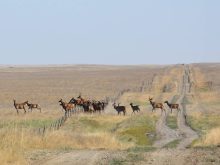Beekeepers who have lost as much as 90 percent of their insects due to varroa mites will likely have difficulty getting replacements, says an Alberta producer.
“The total loss for our operations between last fall and spring was around 50 percent,” said Lorne Prins of the Gull Lake Honey Co. near Lacombe, Alta. He had built up his operation to about 2,000 hives after becoming a beekeeper in 2018.
“And if I just lost 50 percent of my colonies, it would be one thing, but a lot of the remaining colonies are quite weak, so it’s not a great position to be in.”
Read Also

Bunge’s crop mix is changing
Bunge has predominantly been a soybean processing firm, but that’s about to change after the merger with Viterra with softseed processing and grain merchandising gaining ground.
However, he was fortunate in knowing relatively early he had a problem with mites, prompting him to order bees from Australia in October.
Although he expected to get some replacement stock, he said producers who are only now recognizing the magnitude of their losses will be unlikely to get any bees from outside Canada.
“I think the total order for package bees is about four times greater than the package bees that will be available this season.”
Rod Scarlett, executive director of the Canadian Honey Council, estimated average bee losses range from 40 to 45 percent in Alberta, Manitoba and Ontario, rising to about 60 percent in Quebec.
Losses are likely about 30 percent in Saskatchewan, declining to about 20 percent or less in British Columbia and the East Coast, he added.
Prins said canola seed producers “should absolutely be concerned” about the situation.
“It looks like it’s going to be very challenging for them to source the bees they need for pollination on their seed crops.”
However, Scarlett didn’t expect it will have much effect this year on growers in southern Alberta.
“But they are expanding seed canola acreage… if we have the same thing occurring next year, we may start seeing some stress in the system.”
He said blueberry producers in British Columbia and the East Coast will likely face shortages of transported hives this year. “Some blueberry growers may opt to use the bumblebee packages or leafcutter bees. They’re not as effective pollinators, but that may be the only available route for some.”
Varroa mites are parasites that weaken bees, making them more vulnerable to viruses. Although the mites are less than two millimetres long, their proportions compared to a bee are about the same as a fist on a human, he added.
As the vice-president of the Alberta Beekeepers Commission, Prins said he knew of experienced commercial operators who have lost as much as 90 percent of their bees.
“So, there are some people in desperate times.”
The Canadian Honey Council plans to seek government programs to financially help beekeepers, said Scarlett.
“AgriStability will probably kick in for some, but one of the things I think our organization will be looking at is specific government funding.”
The higher losses this spring across much of Canada were largely due to hot weather last year that favoured the spread of the mites, he said. It started with an early spring in 2021 and summer heat waves that continued into the fall, resulting in what Scarlett called a perfect season for growing mites as well as bees.
“And it’s kind of a function of climate change. We have best management practices on varroa controls for beekeepers, but it’s kind of based a little bit on seasonality and timing, and as each season changes and differs, the treatments are going to have to change and differ, and we really haven’t adapted particularly well yet to that.”
Prins called last summer an interesting situation because weather that was good for the growth of bee populations also dried up much of the sources of nectar, “so even though we had really excellent bees, we didn’t end up having a really bumper crop.”
Multiple seasons of lower-than-expected production have resulted in record high prices for honey, he added. “That’s kind of the silver lining…”
As a province that contains the largest segment of Canada’s honey industry, Alberta has not seen a significant increase in total hives in about a decade, he said. “And I think it just goes to show it’s becoming increasingly challenging to keep bees alive.”
The COVID-19 pandemic has “totally screwed up” supply lines for replacement bees from countries such as Australia and New Zealand, said Prins. As a result, many beekeepers would like to see Canada lift a ban on bee imports from the United States, which was put into place to prevent the spread of varroa mites, tracheal mites and small hive beetles, he added.
Due to the fact such pests have crossed the border anyway, the original rationale for the ban is no longer valid, he said.
“The Alberta Beekeepers Commission had a meeting with the Ministry of Agriculture in Alberta essentially pleading to help throw some support behind the opening of the border for package bees coming into Canada.”
However, Scarlett said it would likely take until next year for the Canadian Food Inspection Agency to conduct risk assessments and then decide if it should lift the ban.
Prins added there is also some opposition among Canadian beekeepers to such a move because “there’s this fear that Americans will ship colonies north of the border to produce a honey crop here and then transport the bees back.”
















